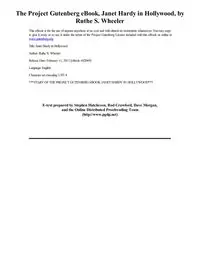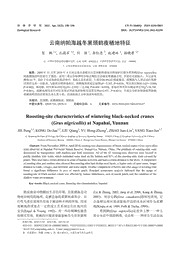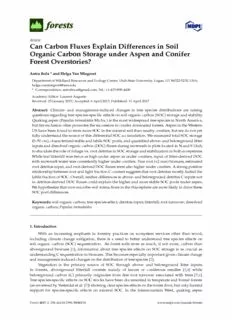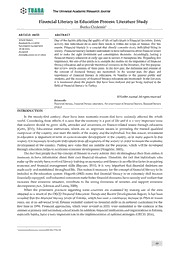
Preview Computing Discourse Semantics
ComputingDiscourseSemantics: ThePredicate-Argument Semantics of Discourse Connectives in D-LTAG KatherineForbes-Riley BonnieWebber AravindJoshi UniversityofPennsylvania UniversityofEdinburgh UniversityofPennsylvania Abstract. D-LTAGis adiscourse-level extension of Lexicalized Tree-Adjoining Grammar (LTAG),in which discourse syntax is projected by different types of discourse connectives and discourse interpretation is a product of compositional rules, anaphora resolution, and inference.Inthispaper,wepresentaD-LTAGextensionofongoingworkonanLTAGsyntax- semanticinterface.First,weshowhowpredicate-argumentsemanticsarecomputedforstan- dard, (cid:148)structural(cid:148) discourse connectives. These are connectives that retrieve their semantic arguments from their D-LTAG syntactic tree. Then we focus on discourse connectives that occursyntacticallyas(usually)frontedadverbials.Theseconnectivesdonotretrieveboththeir semantic arguments from a single D-LTAG syntactic tree. Rather, their predicate-argument structureandinterpretationdistinguishthemfromstructuralconnectivesaswellasfromother adverbials that do not function as discourse connectives. The unique contribution of this paperliesinshowinghowcompositionalrulesandanaphoraresolutioninteractwithintheD- LTAGsyntax-semanticinterfacetoyieldtheirsemanticinterpretations,withmulti-component syntactictreessometimesbeingrequired. 1. Introduction Thenotionthatdiscourserelatestosyntaxandsemanticsinacompletelydif- ferentwaythandoesthesentenceseemsstrangewhenweconsiderexamples such as (1), where an entire discourse is contained within a relative clause, exhibitingthesamecohesiveandargumentativeconnections characteristicof multi-sentential discourses suchas(2). (1) Any farmer who has beaten a donkey but gone home regretting it and hasthenreturnedandapologized tothebeast,deserves forgiveness. (2) Afarmerbeatadonkeybuthewenthomeregrettingit.Thenhereturned andheapologized tothebeast.Asaresulthedeserves forgiveness. Althoughseveraldiscoursemodelsprovideasyntaxandsemanticsfordis- course(Schilder,1997;Gardent,1997;PolanyiandvandenBerg,1996;Scha and Polanyi, 1988), their syntax and semantics differ from what one (cid:2)nds at thesentencelevel.D-LTAGpresentsamodeloflow-leveldiscoursestructure and interpretation that exploits the same mechanisms used at the sentence levelandbuilds themdirectly ontopofclausestructure andinterpretation. In this paper, we address the computation of discourse semantics in D- LTAG.Westartbyintroducing D-LTAGinSection2.Section3thenpresents a D-LTAG extension of ongoing work on an LTAG syntax-semantic inter- face,and showshow itisused tocompute the predicate-argument semantics 2 Forbes-Riley,Webber,Joshi for D-LTAGstructural connectives. In Section 4, we describe how adverbial discourse connectives differ from structural connectives, and from other ad- verbials, in terms oftheir predicate-argument structure and interpretation. In Section 5, we show how their predicate-argument semantics is computed in D-LTAG’ssyntax-semantic interface.InSection6,wecomparethecomputa- tionofdiscourse semantics inD-LTAGwiththatinprevious discourse mod- els. In Section 7, we highlight unresolved issues arising due to the on-going natureofthiswork,bothatthediscourse levelandtheclauselevel. 2. D-LTAG:Anintermediatelevelofdiscourserepresentation D-LTAG (Creswell et al., 2004; Webber et al., 2003; Forbes et al., 2003; Creswelletal.,2003;Creswelletal.,2002;Forbesetal.,2001;Webberetal., 1999b;Webberetal.,1999a;WebberandJoshi,1998)buildsanintermediate level of discourse structure directly on top of the clause. D-LTAG’s syntax is currently modeled using the structures and structure-building operations of a lexicalized tree-adjoining grammar (LTAG) (Joshi and Vijay-Shanker, 1999;XTAG,2001),whichiswidelyusedtomodelthesyntaxofsentences. 2.1. AN INTRODUCTION TO LTAG LTAGis an extension of a tree-adjoining grammar (TAG) (Joshi, 1987) that includes lexicalization and uni(cid:2)cation-based feature structures, and repre- sents the underlying structure of a surface string, as well as the string itself. LTAG consists of 1) a (cid:2)nite set of elementary trees, each associated with at leastonelexicalitem(theanchor),and2)operations forcombiningthem. There are two types of elementary trees in LTAG:initial trees, which en- code basic predicate-argument relations, and auxiliary trees, which encode recursion and(cid:0) must contain a non-terminal node, called the foot node and indicated by ,whose label matches thelabel ofthe root. Therightmost tree inFigure1isanauxiliary tree,alltheothersareinitialtrees. (cid:18) (cid:19) (cid:20) (cid:4)(cid:6)(cid:2) (cid:5) (cid:2) (cid:2) S(cid:1) (cid:1) (cid:1) NP (cid:10)t(cid:18) (cid:12) NP (cid:10)t(cid:19) (cid:12) (cid:15)VP(cid:15) (cid:10)(cid:14)t(cid:20) (cid:14)(cid:12) (cid:3) (cid:7)(cid:9)(cid:8) (cid:10) (cid:11) b b b NP t (cid:15)VP(cid:15) (cid:14)tb(cid:11)(cid:13)(cid:14)(cid:12) (cid:4) (cid:5) N N ADV VP(cid:21) (cid:10)t(cid:20)(cid:20)(cid:19)(cid:19) (cid:12) (cid:16) (cid:17)(cid:8) b V NP t John Fido often walks Figure1. ElementaryLTAGTrees Each elementary tree represents a domain of locality encoding the syn- tactic/semantic arguments of its anchor. An anchor may be associated with multipleelementarytrees;eachtreeinthisfamilyre(cid:3)ectsaminimalsyntactic ComputingDiscourseSemantics 3 construction.Forexample,theverbwalkmaytakethetransitivetreeshownin Figure1oranintransitivetree.Eachnodeinanelementary treeisassociated with at least one feature structure (cid:150) a top feature structure in the case of substitution nodes, and both a top and bottom feature structure in the case of all other nodes. These for several nodes are shown in Figure 1. Feature uni(cid:2)cation then implements the dynamic speci(cid:2)cation of local constraints concerning hownodesinteractduringstructure-building, including linguistic constraints onagreement,case,andtense(XTAG,2001). There are twostructure-building operations in LTAGthat create complex trees, called derived trees: sub(cid:22)stitution and adjunction. Substitution consists of replacing the node marked , as in the leftmost tree in Figure 1, with the treebeingsubstituted. Onlyinitialtreesortreesderivedfrominitialtreescan besubstituted, andtherootnodeofthetreebeingsubstituted mustmatchthe label ofthenode being replaced. Forexample,wecan substitute theNPtree anchored by Fido in Figure 1 for the internal NP argument (annotated here with i) in the tree anchored by walks, and the NP tree anchored by John for theexternal NPargument (annotated herewithe).Ineachcase,theresulting node takes the union of the features of the involved nodes. In this union, the features common to both nodes must match. The remaining featur(cid:23)es are simplyassigned. Forexample, ifthetopagreement features oftheNP node are 3rd person, singular, they must either match the top agreement features oftheNPnodeintheJohntreeorbeassigned. TheNPnodeintheFidotree will not carry case(cid:24) features, so accusative case will be assigned by the top features of the NP node. The derived tree resulting from these substitutions isshowninFigure2(a). (cid:2) (cid:2) (cid:2) (cid:2) S(cid:1) (cid:1) (cid:1) (cid:1) (cid:26) (cid:26) (cid:26) S(cid:25) (cid:25) (cid:25) (cid:7) (cid:18) (cid:11) (cid:20) NP (cid:10)t(cid:18) Ut (cid:12) (cid:26)(cid:26) (cid:26) V(cid:25)P (cid:25)(cid:25) (cid:17) (cid:19) NP (cid:26)V(cid:26) P(cid:26) (cid:10)t(cid:20)(cid:25) Ut(cid:25) (cid:25)(cid:12) bN V NP (cid:10)tb(cid:19)Ut (cid:12) N ADV bVP(cid:28) (cid:28)(cid:10)t(cid:20)(cid:11)(cid:19)(cid:27) (cid:27) (cid:20) (cid:19) (cid:12) walks Joe b Ub Joe N often V NP Fido walks N Fido (a) (b) Figure2. LTAGDerivedTreesAfterSubstitutionandAdjunction Adjunctionisrestrictedtonon-terminalnodesnotalre(cid:29) adymarkedforsub- s(cid:30) titution, and bu(cid:29)ilds a n(cid:30) ew tree from an auxiliary tree a(cid:29) nd any other tree . To combine (cid:31)and (cid:30) by adjunction, the root node of m(cid:29)ust match the label(cid:31)of the node in to which it adjoins. The root nod(cid:29)e of is identi(cid:2)ed with ,theirtopfeaturesunify,andthebottomfeaturesof areinherited;the 4 Forbes-Riley,Webber,Joshi (cid:31) (cid:29) sub(cid:31)treedominatedby isattachedtothefootnodeof ,thebottomfeatures o(cid:31) f unifywiththoseofthefootno(cid:29) de,andtherestofthetreethatdominated nowdominatestherootnodeof .Forexample,thetreeanchoredbyoften inFigure1canadjointotheVPnodeinFigure2(a);theresult,withrelevant featureuni(cid:2)cations,isshowninFigure2(b). Because derived trees such asinFigure 2donot indicate whattreeswere combined or what operations were used to combine them, this information is recorded in an associated derivation tree. A node in a derivation tree is labeled with the elementary tree involved at that point in the derivation; the root of the derivation tree is labeled with the (unique) initial tree that is not substituted into anyother treeinthisderivation. In(cid:29)general, initial treelabels start with , and auxiliary tree labels start with . A tree address is also associated with each node in the derivation tree except the root. This is the address ofthenode inthe parent treeatwhich thesubstitution oradjunction operation has occu!#rr"%e$ d. The address of the root node in the parent tree is 0, t&h"%e$ address of the child of that root’is (k), and (p.q) is the address of the child of the node whose address is . The derivation tree corresponding to Figure 2(b) is shown in Figure 3. (Dashed lines indicate adjunctio )n(+,*-a,/n.10d s 3o25li4d lines, substitution 7.)(+*-T,8h.10e initial tree that ro(cid:23)ots(cid:29)9t4(cid:13)h:is(cid:23) derivation is 7(;*<,/.10. $16 " 6 substitutesinto >= (cid:24)@? 4ataddress(1)(NP 7(+),*-,8.10 adjoinsinto (cid:24) ataddress(2)(VP),and substitutes into ataddress (2.2)(NP ). A#BDC(cid:13)EGFIH A#J<KMLON KMQ(cid:13)R N ATS K P (cid:3) (cid:16)/U (1) (2) (2.2) Figure3. LTAGDerivationTree 2.2. AN INTRODUCTION TO D-LTAG D-LTAG builds on the observation that discourse connectives function syn- tactically andsemantically inthediscourse akintothewayverbsfunction in the clause. In LTAG,verbs are viewed as predicates, which supply relations between entity interpretations of noun phrases (NPs) and/or clauses (Ss), producing asentence interpretation. InD-LTAG,thepredicates arediscourse connectives, whose arguments are entity interpretations derived from either simplediscourseunits(e.g.individualclauses)orcomplexunitsV composedof clausesanddiscourseconnectives.Wewillusethenotation(cid:147)D (cid:148)forboth,to indicatethattheseunitsarebeinganalyzed atthediscourse level. AsinLTAG,each elementary tree inD-LTAGisanchored by atleast one lexical item. Although the research is ongoing, our current view of the set of lexical items that convey discourse-level predication is that it includes subordinating and coordinating conjunctions, an empty connective at clause boundaries that are not marked by an explicit discourse connective, certain ComputingDiscourseSemantics 5 adverbsandprepositionalphrasescalleddiscourseadverbials,andevensome verbformssuchas(cid:147)provided that(cid:148)andimperative(cid:147)suppose(cid:148). D-LTAG has both initial trees and auxiliary trees. Initial trees localize thepredicate-argument dependencies ofdiscourse connectives. Forexample, the tree family associated with subordinating conjunctions contains the two initialtreesshowninFigure4withtheanchoralthough, representing theba- sic syntactic alternations shown in (3a)-(3b) that subordinating conjunctions displayrelativetotheirarguments (Quirketal.,1985).1 (3) a.Johnisveryhardto(cid:2)nd,althoughheisverygenerous. bAlthoughJohnisverygenerous, heisveryhardto(cid:2)nd. (cid:26) (cid:26) (cid:26) (cid:26) D(cid:25)W (cid:25) (cid:25) (cid:25) (cid:15)(cid:15) (cid:15) (cid:15) D(cid:14)XXW (cid:14) (cid:14)(cid:14) (cid:4) (cid:4) (cid:4) (cid:4) W W W W D although D although D D Figure4. D-LTAGInitialTreesforSubordinatingConjunctions InLTAG,subordinatedclausesaretreatedasadjunctsbecausetheyarenot part of the extended projections (e.g. argument structure) of the verb of the mainclause.InD-LTAG,however,itistheextendedprojections ofdiscourse connectivesthatarebeingmodeled:forexample,subordinating conjunctions relate two clausal interpretations toform alarger discourse unit and are thus representedastakingtwostructuralarguments.(Assuch,wecallthemstruc- tural connectives.) As is also true of local dependencies at the clause level (e.g. Apples, Bill says John may like.), these dependencies can be stretched long-distance viaadjunction ofadditional clauseunits,asshownin(4). (4) a.AlthoughJohnisverygenerous - b.ifyouneedsomemoney, c.youonlyhavetoaskhimforit- d.he’sveryhardto(cid:2)nd. TwotypesofauxiliarytreesareusedinD-LTAG.The(cid:2)rstisforstructural connectives that convey a continuation of the prior discourse, e.g. a modi(cid:2)- cation that serves to further a description of a discourse situation or of one or more entities withinY it (Webber et al., 2003). Auxiliary trees for and and theemptyconnective areshowninFigure5.Whilebothargumentsinthese treescomestructurally,onecomesviasubstitution,whiletheothercomesvia adjunctiontoadiscourseunitinthepriordiscourse.Continuationisthusakin tothenotionofelaboration inKnottetal.(2001),asexempli(cid:2)edin(5). (5) Johnwenttothezoo[and/.]H/hetookhiscellphonewithhim. 1 IndisplayingD-LTAGtrees,wesuppressannotationoffeaturestructures,asconstraints onhowdiscoursenodesinteractduringstructurebuildinghavenotyetbeexhaustivelystudied (cf.Section5.4,7).EmpiricalevidenceforsuchconstraintsmaycomefromthePennDiscourse Treebank(Miltsakakietal.,2004;Prasadetal.,2004)aswellasfromtheoreticalstudies. 6 Forbes-Riley,Webber,Joshi (cid:26) (cid:26) (cid:26) (cid:25)W (cid:25) (cid:25) (cid:15)(cid:15) (cid:15) (cid:14)W (cid:14)(cid:14) D (cid:4) D (cid:4) W (cid:21) W W (cid:21) Z W D and D D D Z Figure5. D-LTAGAuxiliaryTreeforandand Y More generally, the relations supplied by and or in these examples are syntactically under-speci(cid:2)ed, analogous to the syntax of noun-noun com- pounds,andtheycanberepresentedinthelexiconassemanticallyunderspec- i(cid:2)ed.2 In many instances there may be additional inferred relations between the incoming unit and the prior discourse over and above simple elaboration (indicated here bycoordination), whichmayberepresented assemantic fea- tures in the (cid:2)nal discoursY e structure. For example, in addition to the simple elaboration relation that supplies between the interpretations of John came home late and Mary berated him in (6), a temporal relation will be inferred between these two clauses and a causal one as well. While these additional inferencesarecriticaltoafullaccountofdiscoursemeaning,becausetheycan becanceled,3 wedonotconsider suchinferences tobepartofcompositional semanticsandhencedonotdiscussthemwithinthesyntax-semanticinterface wepresent hereforD-LTAG. (6) Yesterday,Johncamehomelate[and/.]Maryberated him. Where conjunctions convey more than continuation, they are represented withinitialtrees.Forexample,soconveysaresult relation,asin7: (7) Youdidn’teatyourspinachsoyouwon’tgetdessert. The second type of auxiliary D-LTAGtree, shown in Figure 6, is used to represent discourse adverbials such as then, otherwise, (in the) meanwhile, etc. Like structural connectives, discourse adverbials relate the interpreta- tions of two simple or complex discourse units. However, unlike structural connectives,theyretrieveonlyoneargumentstructurally(cid:150)fromthediscourse unitthey modify. Againthere aretwotrees inthis treefamily too,due to the factthatdiscourse adverbials canappearS-initialandS-(cid:2)nal.4 Exceptfortheirnodelabels,theD-LTAGtreesfordiscourseadverbialsare identicaltoLTAGtreesforS-modifyingadverbials;adjunctionrepresentsthe 2 E.g.Knott(1996)treatsthelexicalsemanticsofconnectivesasfeatureinheritance. 3 Inferenceofacausalrelationcanbecanceledasin(i).Thewell-knownexamplein(ii) showsthatevenaninferenceoftemporalordercanbecanceledaswell. (i)JohncamehomelateandMaryberatedhim.Butitwasbecausehehadforgottentostop atthegrocerystore,ashehadpromised. (ii)Marygotmarried,andshegavebirthtoason,butnotinthatorder. 4 Whilebothdiscourseadverbialsandsubordinateclausescanappearclause-internally,D- LTAGcurrently does not posit separate trees for them. Rather, our D-LTAGparser (Forbes et al., 2003) extracts them from clause-internal position, leaving a trace for information- structureanalysesandrepresentingthemwithanS-initialtree. ComputingDiscourseSemantics 7 optionalcontinuationthatalladverbialsmake.Butsincediscourseadverbials retrieve only one of their argumenV t(cid:0)s structurally (from the discourse unit at the foot of the adjunction site D ), D-LTAG must account for where the otherargumentcomesfrom.Elsewherewehaveargued(Webberetal.,2003) thatitisprovided anaphorically. \ \ [W[ \ \ [W[ D D W](cid:21) W](cid:21) D then then D Figure6. D-LTAGAuxiliaryTreesforDiscourseAdverbials Thisdistinction betweenstructuralandanaphoric connectivesinD-LTAG is based on considerations of computational economy and behavioral evi- dence from cases of multiple connectives (Webber et al., 1999b). In (8), because encodes a causal relation between the event of Sally raising ire and Sallyenjoyingcheeseburgers, whileneverthelessencodesaviolatedexpecta- tion relation between Sally enjoying cheeseburgers and Sally subscribing to theVegetarianTimes(Creswelletal.,2002). (8) a.Sallysubscribes toVegetarianTimes. b.Lately,she’sraisedtheireofherveganfriends c.because shenevertheless enjoys theoccasional baconcheeseburger. To model both because and nevertheless as structural connectives would create a directed acyclic graph with crossing dependencies, which goes be- yond the computational power of LTAG and creates a completely uncon- strained model of discourse structure (Webber et al.,2003). However, inves- tigations into the behavior of discourse connectives reveal that while sub- ordinating and coordinating conjunctions are constrained to take adjacent discoursesegmentsoflikesyntactictypeastheirarguments,discourseadver- bials seem to share many properties with anaphora. For example, discourse adverbialscan(likeNPanaphora)taketheirpriorargumentintra-sententially asin(9),whereembeddedneverthelessrelatestheinterpretationofthematrix clausetotheinterpretation oftherelativeclause(Webberetal.,2003). (9) Many people who have developed network software have nevertheless nevergottenveryrich.(i.e.despitehaving developed networksoftware) AnotherfeaturethatdiscourseadverbialssharewithanaphoricNPsisthat they can access inferred entities as well as ones introduced explicitly. For example, in (10a) the discourse adverbial otherwise can access the inferred condition of if the light is not red. This material is not available to struc- tural connectives: that is, or in (10b) can only access what is to its left (cid:150) the consequent clause(stop)ortheantecedent(cid:150)consequent pair. 8 Forbes-Riley,Webber,Joshi (10) a.Ifthelightisred,stop.Otherwisegostraighton. b.Ifthelightisred,stop,orgostraight on. Furthermore,aproperty ofallEnglishstructural predicates isthattheydo notallowcrossing ofpredicate-argument dependencies.5 Forexample,while example (4) above is interpretable as an embedded if S1, S2 construction within an although S1’, S2’ construction, crossing these dependencies as in (11) is either uninterpretable or at least yields a different interpretation; the dependencies intheoriginal constructions arelost. (11) a.AlthoughJohnisverygenerous - b.ifyouneedsomemoney- d.he’sveryhardto(cid:2)nd- c.youonlyhavetoaskhimforit. However,discourse adverbials doallow crossing dependencies, asshown in(12)(Webberetal.,2003).Forthenin(d)togetits(cid:2)rstargumentfrom(b), itmustcrossthestructural connection betweentheclausesin(c)and(d)that arerelatedbybecause.Ofcourse,asWebberetal.(200^ 3)note,it_isco^ mmon foranaph_oratoshowcrossingdependencies(e.g.John toldMike he would meethim later.).Whetheralldiscourseadverbials allowcrossingdependen- cies is still an unanswered empirical question. Forbes et al. (2003) outline an empirically-based approach to modeling discourse connectives, in which predicate-argument dependencies are de(cid:2)ned structurally until contradicted bycorpusexamples. (12) a.JohnlovesBarolo. b.Soheorderedthreecasesofthe’97. c.Buthehadtocanceltheorder d.because thenhediscoveredhewasbroke. Thereisoneexceptiontodiscourseadverbialsbeingassociatedwithauxil- iarytrees,andthatisforparallelconstructions, i.e.pairedconnectiveswhich togetherassertdisjunction ((cid:147)either...or(cid:148)),addition(cid:147)notonly...butalso(cid:148)),con- cession ((cid:147)admittedly...but(cid:148)), and contrast ((cid:147)on the one hand...on the other hand(cid:148)). Because of the interpreted inter-dependency of the connectives in theseconstructions, theyaremodeledwithinitialtrees,asinFigure7. Parallel constructions have multiple anchors, but one or the other anchor may not be realized: for example, (cid:147)or(cid:148) without (cid:147)either(cid:148), (cid:147)not only(cid:148) without (cid:147)butalso(cid:148),or(cid:147)ontheotherhand(cid:148)without(cid:147)ontheonehand(cid:148).Onemightargue inthelattercasethatanauxiliarytreeshouldbeusedinsteadofaninitialtree, accessing the non-structural argument of (cid:147)on the other hand(cid:148) anaphorically. But this is best viewed as an empirical question whose answer depends on 5 CrossingispossibleinDutchclauses,e.g.theDutchversionof(cid:147)Theratthecatthedog chasedatedied.(cid:148)Butthereisnoevidence,eveninDutch,ofcrossingstructuralconnectives. ComputingDiscourseSemantics 9 aa a a a a D‘W ‘ ‘ ‘ ‘‘ (cid:26) (cid:26) (cid:26) (cid:25)W (cid:25) (cid:25) (cid:26) (cid:26) (cid:26) (cid:25)W (cid:25) (cid:25) D (cid:4) D (cid:4) W W Ontheonehand D Ontheotherhand D Figure7. D-LTAGInitialTreeforParallelAdverbialConstructions where the other argument is found. Data from the annotated corpus that will comprise thePennDiscourse Treebank(Miltsakaki etal.,2004;Prasad etal., 2004)willhelpanswerthisquestion. We conclude this section by making clear our assumptions about dis- coursestructure.Whileweassumethatdiscourseisprimarilytree-structured, thereareafewsimpleexceptions thatrequire simpleDAGs(directed acyclic graphs).First,aswenotein(Webberetal.,2003),wemustallowforexamples suchas(13)fromBateman(1999): (13) ...(vi)The(cid:2)rst to do that were the German jewelers, (vii) in particular Klaus Burie. (viii) AndMorris followed very quickly after, (ix) using a lacquetry technique tomakethebrooch, (x)andusing acrylics, (xi)and exploring the use of colour, (xii) and colour is another thing that was newatthattime... Bateman analyzes this example as containing a transitional clause (here, clause viii) that stands in one relationship (here succession, aka sequence) to the clause preceding it (here, clause vi) and another relationship (here, manner) to the clause following it (here, clause ix). The result illustrated in Figure8(1)isasimpleDAGinwhichanodehasmorethanoneparent. elaboration succession manner elaboration (vi) (viii) (ix) a b c (1) (2) Figure8. Simplemulti-parentstructurefor(1)(cid:147)transitional(cid:148)clause,(2)clausewithindepen- dentpost-modi(cid:2)ers Second, we may want to allow for a discourse structure that corresponds in clause-level syntax to a head with independent post-modi(cid:2)ers, as in (14). Inthiscase,bothpost-modi(cid:2)ers(b)and(c)relateasindependentelaborations ofthemainclause(a),asillustrated inFigure8(2). (14) a.JohnlovesBarolo. b.He(cid:2)rsttasteditin1992. c.According toHughJohnson,it’soneofItaly’ssupremereds. 10 Forbes-Riley,Webber,Joshi This is again a simple DAG, in which a node has more than one parent. BothcaseswouldrequirethatD-LTAGbeextendedtoallowthesameelement tosubstituteintomorethanonetree(ortoallowanelementtobothsubstitute intoonetreeandserveasanadjunction siteforanauxiliary tree). But neither simple DAG (Figure 8 (1) or (2)) has crossing structural de- pendencies: While the structure of Figure 8 (2) can be drawn in such a way thatthearcfrom(a)to(b)crossesthearcfrom(a)to(c),simplydroppingthe arc from (a) to (b) lower down in the (cid:2)gure removes it. So, contra (Danlos, 2004), this type of structure has no intrinsic crossing structural dependency, and we continue to believe that the cost of moving to arbitrary DAGs for discourse structure is too great to be taken lightly. In fact, the one discourse structure given in (Danlos, 2004) of a DAG with real crossing dependencies is one that she herself excludes as an analysis as violating what she calls a left1-right2 principle. While the syntax-semantic interface given in Section 3 does not cover the structures given in Figures 8, it is because the adjoining and substitution operatorsinTAGdonotletusproducethem.Thiswouldhavetobeaddressed insubsequent work. Wenowturntoourproposed syntax-semantic interface forD-LTAG. 3. ASyntax-SemanticInterface(SSI)forD-LTAG:Part1 3.1. STARTING POINT: SSIS FOR LTAG Joshi and Vijay-Shanker (1999) were the (cid:2)rst to propose an SSI for LTAG. Theysuggested thatifsubstitution andadjunction areviewedasattachments ofonetreetoanothertree,thenasyntacticderivationconsistsofanunordered set of attachments whose semantics can built monotonically and described by a (cid:3)at semantic representation. For example, the (cid:3)at semantic representa- tion corresponding to Figure 2(b) might be as in (15), where i1, i2 denote individuals ande1denotesanevent. b b b (15) john(i1) Fido(i1) walks(e1,i1,i2) often(e1) Theproblem that Joshi and Vijay-Shanker (1999) note, isthat adjunction does not preserve monotonicity with respect to immediate dominance.6 Al- though syntactic under-speci(cid:2)cation ofimmediatedominance wouldremove this non-monotonicity, the tacit assumption in many LTAG formalisms is that the nodes along the spine of a tree (the path from the root to the an- chor) are not distinguished semantically. As an alternative to this syntactic under-speci(cid:2)cation, Joshi and Vijay-Shanker (1999), Candito and Kahane 6 For example, in Figure 2(a), theA VKMQ(cid:13)PR(cid:3)tNhat is immediately dominated by S immediately dominatesV,butinFigure2(b),after isadjoined,thisisnolongerthecase.
Description:The list of books you might like

As Good as Dead

Believe Me

The Subtle Art of Not Giving a F*ck

Do Epic Shit

Selected topics in number theory

The Bright Book of Life

Magic Shifts

Understanding Real Analysis

Supersymmetry Without Prejudice

Hacker im Wandel der Zeit: über die differenzierte Verwendung des Hackerbegriffes

32073 Amherst Annual Report 2012-2013_web.indd

Hopscotch: A Novel

Biological Conservation 2006: Vol 127 Index
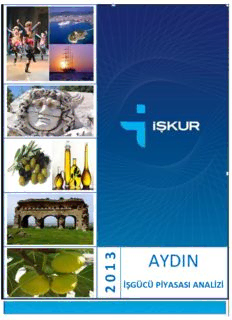
Aydın Çalışma ve İş Kurumu İl Müdürlüğü Resmi Web Sitesi

by Carmen Agra Deedy illustrated by Renato Alarcão The Frog Princess

Mor Jibon Mor Abhisap Ed. 1st

Greek Government Gazette: Part 1, 2006 no. 75
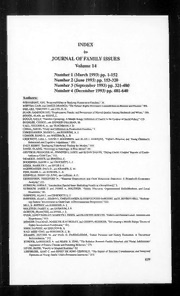
Journal of Family Issues 1993: Vol 14 Index
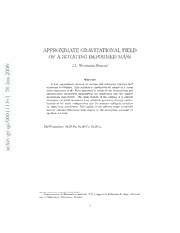
Approximate gravitational field of a rotating deformed mass
